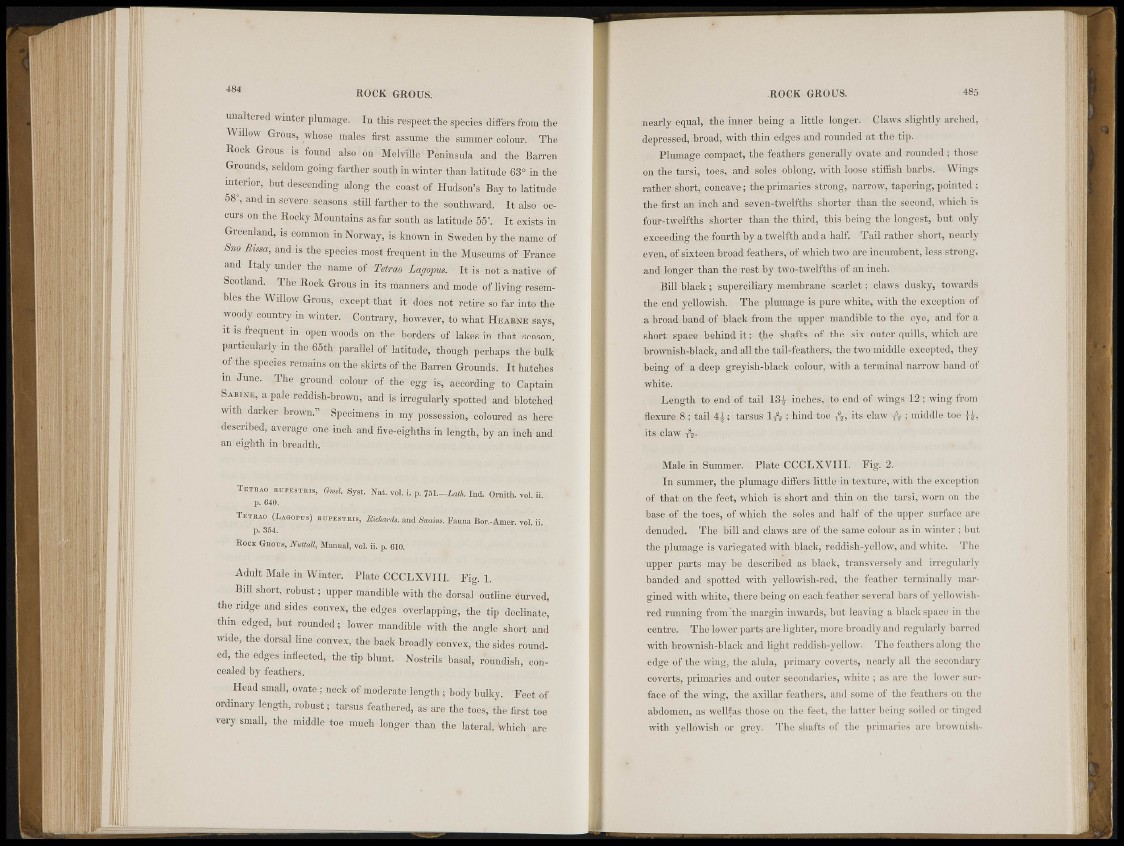
484 ROCK (iliOUS.
unaltered winter plumage. In this respect the»sfecies differs from t f c
Wiliw Grous, whose- males first assume the summer colour. The
Rock Grams is found alio -on MelvSUr Peninsula and the Barren
Grounds;, seldom going farther south in winter than latitude 63° in the
interior, hut of Hudson's Bay to lffimde
a & a h d in « f t®« seasons , « 1 farther to the southward. It also occurs
oi, the Rocky Mountains as far sot»th as latitude 55°. It exists in
Greenland, ià''common in Norway, is known® Sweden by th<i!ffiiMet of
»»0 Sissa, and is the species most frequent inlthe Musetto^ of »Fran®
and Italy under the name of detrai 'Lhgotfua. ' It is not a ììative of
Scotland The Rock Grous im ife manners and mode of iïving refe<tobles
th.- Willow- Grous-,- ertept that it d.mk n.,t retire so far into thè
woody country in winter. Contrary, hóweVèr, to what Hkab-kk sigi,
it is ftequiht m open woods to the borders of lakes lit that »season,
particularly in the 65th parallel of-1 latitude, though perhaps thè bulk ,
of-the species remains.1«.'(ho skin* of the Barren Grounds. It'hatches
in June , The gremnd côli&r w A ^ À ^ W d f f i t 'tB«<Captam
Sabme, a pale reddish-brown, and is irregularly spotted and blófthed
w i t h ,1,u'k ( î r lmn™-'! - ¡Specimens in my
described, average one inch and fivft%htl,s in length, by an inch and
an eighth in breadth.
T®*M k » » M « , Bo*. Nat. vol. j. p. 751.-Lath. Ind. Oimth. vol. fi.
!yB tea.
(I.agoim-s) HctïSTBis, M o * . andA>ata. pinna Bor.-Amer. voi.ii
p. .154. ' '
Iìock Choi:«, iPiiè&B, Manual, vol. ii. ¡,. 010.
Adult Male m Wrntei. Plate CCCLXVIlIy1 Fig. 1.
- Hill short, robust ; upper mandible with tin, dorsal outline Curved,
the ridge and s i t e convex,, the e'dgfes overlapping, the tip •flecHnate,
thin edged, tat rounded ; lower mandi » with the angle short and '
wideyrthe dorsal line con-vex, the back b roadlyWex, thesidfes rounded,
the edges -inflected,"the tap blunt. Nostrils basal, roundish, conc.
oalod by feathers.
Head small, ovate.; neck of moderate'length; body bulky, feet of '•
ordinary length, robust ; tarsus feathered, as are the toes, the first toe
veryismall,i the middle'toe much longer than the lat'erali%hich are
ROCK GROUS. 485
nearly equal, tlie inner being a little longer. ' Claws slightly arched,
depressed, .broad, with thin, edges, and rounded at the tip.
Plumage compact, the feathers generally ovate and rounded ; those
on the tarsi, toes, and stiles oblong, with loose stiffish barbs. Wings
rather short, concave ; the primarie:.-» Strong, narrow, tapering, pointed ;
the: first an inch' and seven-twelfths Shorter than the second, which is
four-twelfths shorter than the third, this being the longest, but only
exceeding the fourth by a twelfth and a half. Tail rather short, nearly
even, of sixteen broad feat hers,-of which two are incumbent, less strong,
and .longer than the rest .by two. twelfth» of an inch.
Bill black 5s superciliary membrane scarlet ; claws dusky, towards
the end yellowish. The plumage is pure white, with the exception of
a liroad band of ¡black from the upper mandible to the eye, and for a
short space behind it : tins shafts oi' Ilio six outer quills, which are
brownish-black, and all. the tail-feathers, the two middle excepted, they
being of a deci' .greyish-black colour, with a terminal narrow band of
fW'hite. . •
Length to end of tail 13^ inch®!,I® end of wings 12 ; wing from
iluxuru 8 ; tail -14: tarsus I ft ; hind toe ft, its claw ft ; middle toe R
it.« claw ft.. I •
Male.in Summer, ..' Plaite CCGl.XVIII. Pig. 2.
^•summer, the plumage ditTors little-in texture, with the exception
of that on the feet, which is short and thin on tie tarsi, worn on thé
base of the toe», of which the soles and half of the upper surface are
denuded. Baft bill and claws are of the same colour as in winter ; but
the plumage is variegated with black, reddish-yellow, and white. The
upper parts may be described as black, transversely and irregularly
banded and spotted with yellowish-red, the feather terminally margined
with white, there being on each feather several bars of yellowishred
running from "the: margin inwards, but leaving a black space in the
centre. The lower parts aro lighter, more broadly and regularly barred
with brownish-black and light reddish-yellow. The feathers along thè
edge of the wins', the alula, primary coverts, nearly all the secondary
coverts, primaries and outer secondaries, white ; as are the lower surface
of the wing, the axillar feathers, and some of the feathers on the
abdomen, as wellfas those on the feet, the latter being soiled or tinged
with y ellowish or grey. The shafts of the primaries are brownish